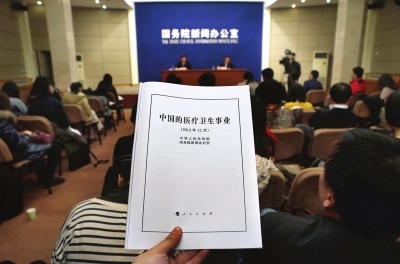| 一、衛生基本狀況 |
I. Basic Conditions |
| 居民健康狀況不斷改善。從反映國民健康狀況的重要指標看,中國居民的健康水平已處于發展中國家前列。2010年人均期望壽命達到74.8歲,其中男性72.4歲,女性77.4歲。孕產婦死亡率從2002年的51.3/10萬下降到2011年的26.1/10萬。嬰兒死亡率及5歲以下兒童死亡率持續下降,嬰兒死亡率從2002年的29.2‰下降到2011年的12.1‰,5歲以下兒童死亡率從2002年的34.9‰下降到2011年的15.6‰,提前實現聯合國千年發展目標。 |
The people's health has been improved. Judging from important indicators that give expression to national health, the health of the Chinese people is now among the top in developing countries. In 2010, the life expectancy was 74.8 years - 72.4 years for males and 77.4 years for females; the maternal mortality rate went down from 51.3 per 100,000 in 2002 to 26.1 per 100,000 in 2011; the infant mortality rate and the mortality rate of children under the age of five have kept dropping, with the former going down from 29.2 per thousand in 2002 to 12.1 per thousand in 2011, and the latter, from 34.9 per thousand to 15.6 per thousand, attaining ahead of schedule the UN Millennium Development Goal in this regard. |
| 建立起覆蓋城鄉的醫療衛生體系。一是公共衛生服務體系。包括疾病預防控制、健康教育、婦幼保健、精神衛生、衛生應急、采供血、衛生監督和計劃生育等專業公共衛生服務網絡,以及以基層醫療衛生服務網絡為基礎、承擔公共衛生服務功能的醫療衛生服務體系。二是醫療服務體系。在農村建立起以縣級醫院為龍頭、鄉鎮衛生院和村衛生室為基礎的農村三級醫療衛生服務網絡,在城市建立起各級各類醫院與社區衛生服務機構分工協作的新型城市醫療衛生服務體系。三是醫療保障體系。這個體系以基本醫療保障為主體、其他多種形式補充醫療保險和商業健康保險為補充。基本醫療保障體系包括城鎮職工基本醫療保險、城鎮居民基本醫療保險、新型農村合作醫療和城鄉醫療救助,分別覆蓋城鎮就業人口、城鎮非就業人口、農村人口和城鄉困難人群。四是藥品供應保障體系。包括藥品的生產、流通、價格管理、采購、配送、使用。近期重點是建立國家基本藥物制度。 |
Medical and healthcare systems covering both urban and rural residents have been put in place. Of these systems, the first is the public health service system, which covers disease prevention and control, health education, maternity and child care, mental health, health emergency response, blood collection and supply, health supervision, family planning and some other specialized public health services, and a medical and healthcare system based on community-level healthcare networks that provides public health services. The second is the medical care system. In the rural areas, it refers to a three-level medical service network that comprises the county hospital, the township hospitals and village clinics, with the county hospital performing the leading role, and township hospitals and village clinics service at the base. And in the cities and towns, it refers to a new type of urban medical health service system that features division of responsibilities as well as cooperation among various types of hospitals at all levels and community healthcare centers. The third is the medical security system. This system comprises mainly the basic medical security, supported by many forms of supplementary medical insurance and commercial health insurance. The basic medical security system covers basic medical insurance for working urban residents, basic medical insurance for non-working urban residents, a new type of rural cooperative medical care and urban-rural medical aid, which cover, respectively, the employed urban population, unemployed urban population, rural population and people suffering from economic difficulties. And the fourth is the pharmaceutical supply system, which covers the production, circulation, price control, procurement, dispatching and use of pharmaceuticals. The recent work is focused on establishing a national system for basic drugs. |
| 衛生籌資結構不斷優化。衛生籌資來源包括政府一般稅收、社會醫療保險、商業健康保險和居民自費等多種渠道。2011年,中國衛生總費用達24345.91億元人民幣,同期人均衛生總費用為1806.95元人民幣,衛生總費用占國內生產總值的比重為5.1%。按可比價格計算,1978—2011年,中國衛生總費用年平均增長速度為11.32%。個人現金衛生支出由2002年的57.7%下降到2011年的34.8%,衛生籌資系統的風險保護水平和再分配作用不斷提高。2011年,醫院、門診機構費用為18089.4億元人民幣,公共衛生機構費用為2040.67億元人民幣,分別占衛生總費用的71.74%和8.09%。醫院費用中,城市醫院、縣醫院、社區衛生服務中心、鄉鎮衛生院費用分別占64.13%、21.28%、5.17%、9.3%。 |
The health financing structure has been constantly improved. China's health expenditure comes from the government's general tax revenue, social medical insurance, commercial health insurance, residents' out-of-pocket spending, etc. In 2011, the total health expenditure in China reached 2,434.591 billion yuan, 1,806.95 yuan per capita. The total expenditure accounted for 5.1% of the country's GDP. In comparable prices, the health expenditure grew by an average annual rate of 11.32% from 1978 to 2011. Individual "out-of-pocket" spending declined from 57.7% in 2002 to 34.8% in 2011, showing that health financing is working better in the areas of risk protection and re-distribution. In 2011, the spending on hospitals and outpatient establishments was 1,808.94 billion yuan, and that on public health agencies, 204.067 billion yuan, comprising 71.74% and 8.09%, respectively, of the total health expenditure. Of the total spending on hospitals, those on urban hospitals, county hospitals, community health service centers and township health service centers stood at 64.13%, 21.28%, 5.17% and 9.3%, respectively. |
| 衛生資源持續發展。截至2011年底,全國醫療衛生機構達95.4萬個(所),與2003年比較,醫療衛生機構增加14.8萬個(所)。執業(助理)醫師246.6萬人,每千人口執業(助理)醫師數由2002年的1.5人增加到1.8人。注冊護士224.4萬人,每千人口注冊護士數由2002年的1人增加到1.7人。醫療衛生機構床位數516萬張,每千人口醫療衛生機構床位數由2002年的2.5張提高到3.8張。 |
Health resources have been developing in a sustained way. By the end of 2011, medical and healthcare institutions around the country totaled 954,000, an increase of 148,000 over 2003. Licensed doctors (assistants) reached 2,466,000, or 1.8 per thousand people, as compared with 1.5 per thousand people in 2002. Registered nurses totaled 2,244,000, or 1.7 per thousand people, as compared with one per thousand people in 2002. The number of hospital beds reached 5160,000, or 3.8 per thousand people, as compared with 2.5 per thou-sand people in 2002. |
| 醫療衛生服務利用狀況顯著改善。2011年,全國醫療機構診療人次由2002年的21.5億人次增加到62.7億人次,住院人數由2002年的5991萬人增加到1.5億人。中國居民到醫療衛生機構年均就診4.6次,每百居民住院11.3人,醫院病床使用率為88.5%,醫院出院者平均住院日為10.3天。居民看病就醫更加方便,可及性顯著提高。15分鐘內可到達醫療機構住戶比例,由2003年的80.7%提高到2011年的83.3%,其中農村地區為80.8%。醫療質量管理和控制體系不斷完善。建立無償獻血制度,血液安全得到保障。 |
Marked improvement has been seen in the utilization of medical and health services. In 2011, medical institutions throughout the country hosted 6.27 billion outpatients, as compared with 2.15 billion in 2002; and admitted 150 million inpatients, as compared with 59.91 million in 2002. That year, Chinese residents went to the medical institutions for medical treatment 4.6 times on average; 11.3 of every 100 people were hospitalized; the utilization rate of hospital beds reached 88.5%; and the hospital stay of the inpatients averaged 10.3 days. These figures show that it has become increasingly convenient to see a doctor and more easily accessible to get medical services. In 2011, 83.3% of all households (80.8% in rural areas) could reach medical institutions within 15 minutes, as compared with 80.7% in 2002. Medical service quality management and control systems have been constantly improved. A system of blood donation without compensation has been established, so as to ensure blood supply and safety. |
| 跳轉至目錄 >> |
Back to Contents >> |
 0
0 






